最新雅思写作流程图Flow-chart讲义
- 格式:doc
- 大小:2.53 MB
- 文档页数:10
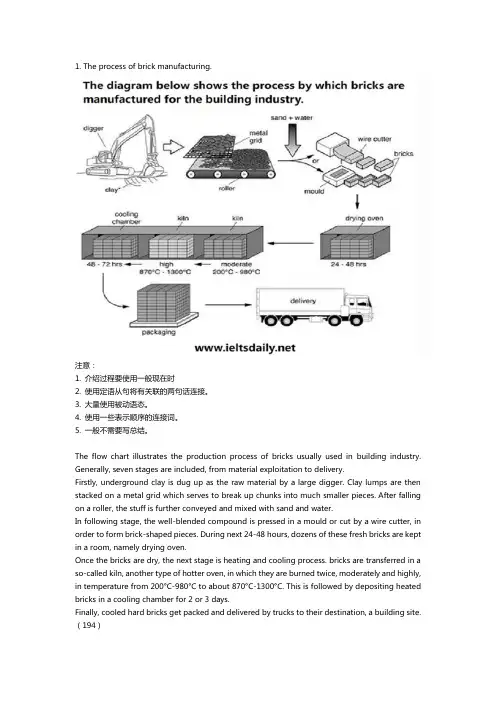
1. The process of brick manufacturing.注意:1. 介绍过程要使用一般现在时2. 使用定语从句将有关联的两句话连接。
3. 大量使用被动语态。
4. 使用一些表示顺序的连接词。
5. 一般不需要写总结。
The flow chart illustrates the production process of bricks usually used in building industry. Generally, seven stages are included, from material exploitation to delivery.Firstly, underground clay is dug up as the raw material by a large digger. Clay lumps are then stacked on a metal grid which serves to break up chunks into much smaller pieces. After falling on a roller, the stuff is further conveyed and mixed with sand and water.In following stage, the well-blended compound is pressed in a mould or cut by a wire cutter, in order to form brick-shaped pieces. During next 24-48 hours, dozens of these fresh bricks are kept in a room, namely drying oven.Once the bricks are dry, the next stage is heating and cooling process. bricks are transferred in a so-called kiln, another type of hotter oven, in which they are burned twice, moderately and highly, in temperature from 200°C-980°C to about 870°C-1300°C. This is followed by depositing heated bricks in a cooling chamber for 2 or 3 days.Finally, cooled hard bricks get packed and delivered by trucks to their destination, a building site.(194)2. The production of steam using a gas cooled nuclear reactor.1. 看懂基本过程和原理,定位流程的起点和终点。
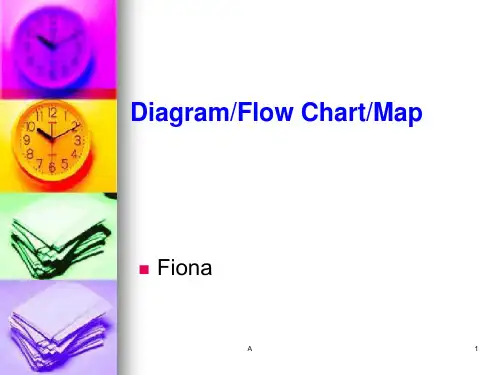
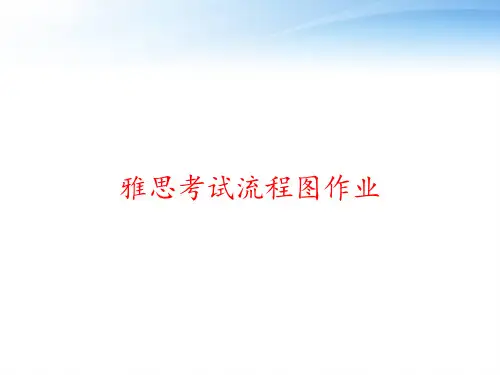
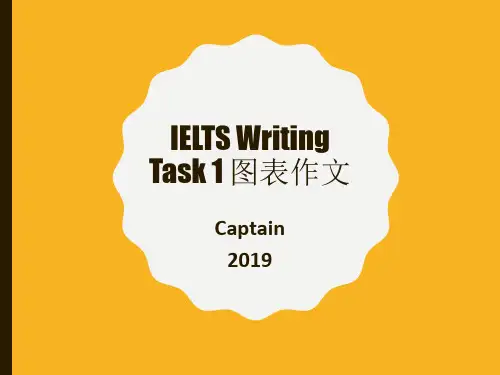
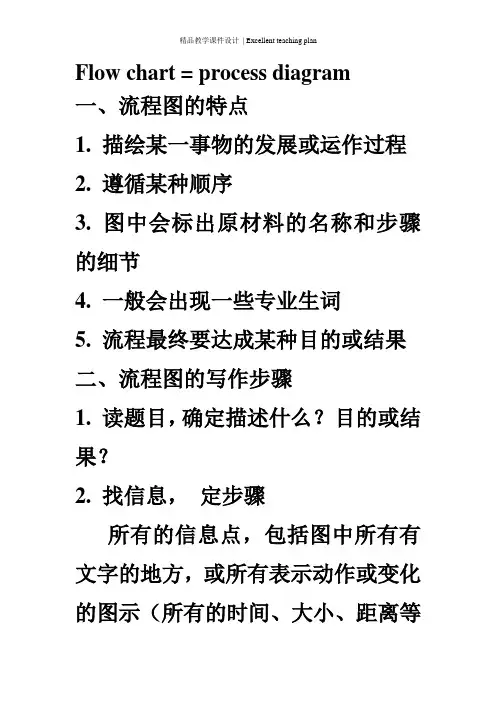
Flow chart = process diagram一、流程图的特点1. 描绘某一事物的发展或运作过程2. 遵循某种顺序3. 图中会标出原材料的名称和步骤的细节4. 一般会出现一些专业生词5. 流程最终要达成某种目的或结果二、流程图的写作步骤1. 读题目,确定描述什么?目的或结果?2. 找信息,定步骤所有的信息点,包括图中所有有文字的地方,或所有表示动作或变化的图示(所有的时间、大小、距离等数字信息)1.定框架,写文章第一段:介绍流程图是做什么的。
第二段:详细介绍原料与准备、每一步的变化、过程及结果。
第三段:简单总结2.读文章,做检查单词拼写、语法、替换重复的词汇等。
三.流程图常用的表达1. The flow chart illustrates the recycling process of _____.2. The process of ____ involves the following steps.3. The whole procedure of ___ can be categorised into ____ stages.4. The row materials for ____ include ___, ___ and ____.5. The first step is to ______.6. ____ with ____ is prepared to _____.7. ____ is used as ____ of ____.8. _____ is mixed with ____ to produce _____.9. _____ can change into ____, when ____.10. The process of ____ is really a simple(complicated) process.The pictures below show the recycling process of wasted glass bottles.As is displayed in the flow chart, the recycling process of glass is really a complex one.The overall process can be categorised=classified=divided into three stages.First, glass products in various forms are gathered=assembled in the Collection point, so that they are easily transported by special trucks or vans to the Cleaning plant, where they get sterilisation byhigh-pressured water. There are three different channels in the Recycling plant, namely Brown, Green and Clear, which represent the colors of glass. After recycled in the furnace, glass products are melted=forged into recycled liquid glass. Mixed with new liquid glass, the compound is finally moulded into solid glass, which, afterwards, will be sent to various customer supermarkets for selling. Thus, the glass will go to the customers for different purposes.Through a brief introduction of the circle of glass recycling, we come to realize that recycling plays a vital role in environmental protection and ecological preservation.The diagram below describes how to recycle organic waste to produce compost(fertilizer).1. The flow chart illustrates the recycling process of organic waste to produce fertilizer.As is clearly shown in the picture, thefirst step is to find a plastic container of two cubic metres and stab several holes on its body so that air could fill in. Secondly, a 15cm thick layer of food is placed at the bottom of the container and grass is put just above the layer for the same height with some news paper covered on the very top. After that, some nitrogen and water are added into the container, and the water should only be hot. Finally, the container is sealed up and the external heat would help the formation of the compost. After six months, when the fertilizer is ready, all we have to do is to pour it into garden soil to nourish plants and flowers.Generally speaking, making garden fertilizer in this way is easy to operate but it costs much time.2. The flow chart shows the wholeprocess of producing fertilizer by recycling organic waste.Firstly, a two cubic metres plastic container is prepared, with some air holes on its body. Secondly, some organic waste is put into the plastic container. The organic waste includes news paper, grass and food. The right order of adding them is putting food in the bottom 15cm of the container and grass in the middle 15cm upon food. News paper is on the very top. Then nitrogen and water are added into the container. What should be noticed is that water can only be hot water. The next step is to seal up and heat the container. After six months, compost is produced. So we can use them to fertilize the garden.As can be seen from the picture, it isusually simple to change organic waste into fertilizer used to water flowers and trees in the garden.3. The information provided in the diagram is about how to use organic waste to produce compost in the following several simple stages.The first stage is to prepare a plastic container, two cubic metres in volume, with some ventilation holes on the side. Then organic waste such as leaves, pieces of paper and residues can be placed into the container so that three layers (each 15 cm) can be formed in the bottom---news paper, grass and food respectively from up to down. The next important step is to add nitrogen into it and then pour hot water only in to mix together. What is remembered to do next is that the container needs to besealed and heated. As a result, the vapor can be emitted through the holes located on its body. After that it takes roughly six months to convert into composts and then they are ready for fertilizing plants and flowers in the garden.。
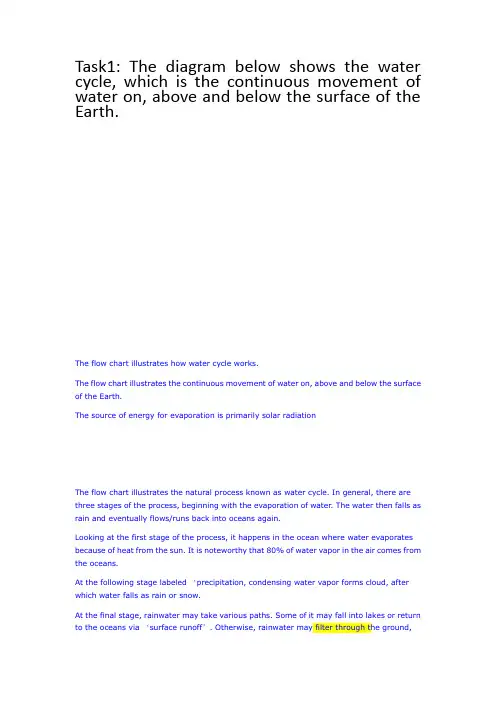
Task1: The diagram below shows the water cycle, which is the continuous movement of water on, above and below the surface of the Earth.The flow chart illustrates how water cycle works.The flow chart illustrates the continuous movement of water on, above and below the surface of the Earth.The source of energy for evaporation is primarily solar radiationThe flow chart illustrates the natural process known as water cycle. In general, there are three stages of the process, beginning with the evaporation of water. The water then falls as rain and eventually flows/runs back into oceans again.Looking at the first stage of the process, it happens in the ocean where water evaporates because of heat from the sun. It is noteworthy that 80% of water vapor in the air comes from the oceans.At the following stage labeled ‘precipitation, condensing water vapor forms cloud, after which water falls as rain or snow.At the final stage, rainwater may take various paths. Some of it may fall into lakes or return to the oceans via ‘surface runoff’. Otherwise, rainwater may filter through the ground,storing between the surface and impervious layer as groundwater. Salt water intrusion is shown to take place just before water passes into the oceans to complete the cycle.。
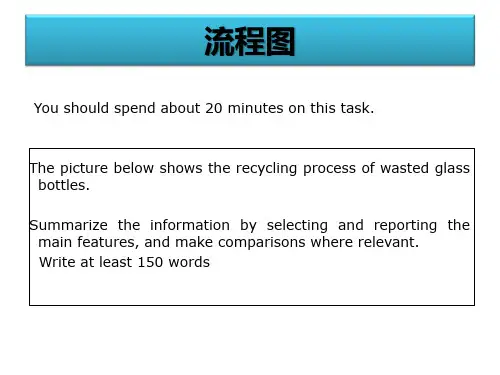

雅思小作文-流程图The diagram below shows the typical stages of consumer goods manufacturing, including the process by which information is fed back to earlier stages to enable adjustment.Write a report for a university lecturer describing the process shown.Sample Answer 1:The given diagram shows the stages of manufacturing and process adjustment of the consumer goods. As is observed from the flow chart, the goods manufacturing is a complex process which is done in several stages and information is sometimes fed back to earlier stages to make some adjustments.Firstly, raw materials and other components are stored together and production planning is done. There are two major process involves in the overall manufacturing process: one is manufacturing process itself and another one is the information feedback process with which the adjustment of the manufacturing is done. After the product research, the design part is done and this input is used in product planning stage. After the production planning is complete the assembly, inspection, testing and packaging stages are done sequentially. Feedback from testing phase is used in design stage and which led back to product planning stage. Again, the market research affects the design and advertising stages and inputs from the market research stage is used in packaging stage. The final two stages are dispatch and sales. The information flow stages gives feedback to other stages to refine and adjust the process.In summary, the consumer goods manufacturing process involves both themulti-staged manufacturing and research methods. The manufacturing stages involve the storage, assembly, inspection, packing to the sales methods whereas the research stages include market & product research, design and advertisement.(Approximately 231 words)Sample Answer 2:The given diagram shows the steps of consumer products manufacturing process, as is clearly show in the diagram that goods manufacturing is a complex process from collection of raw materials to the end product.As the process clearly shows the first stage of product development is collection and storage of raw materials and manufacturing components. The second stage is designing of the products and production planning and it’s a lengthy process which includes supervision and monitoring designing progress frequently, and before marketsurvey it is necessary to test the product to being aware the quality of the product. If the product is quality wise good then the next stage is packing of the products and make advertise for sale. In this production and manufacturing process there are mainly two types of process: flow of manufacturing process and flow of information feedback.In summary, it is value chain development process that starts from collection of raw materials to the end or final product for sale, in each stage of this manufacturing process value is added to products.(Approximately 176 words)。
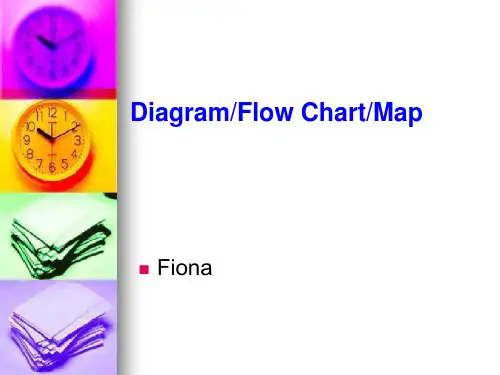
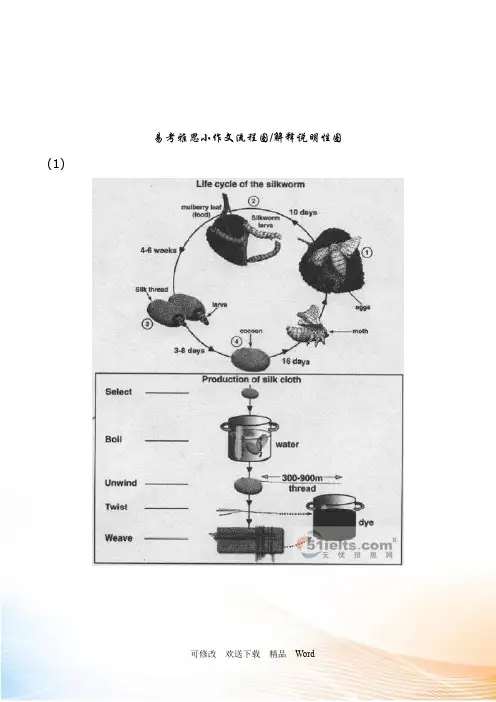
易考雅思小作文流程图/解释说明性图(1)(2)You should spend about 20 minutes on this task.The diagram below shows the method of obtaining water outdoors. You should write at least 150 words.(3)You should spend about 20 minutes on this task.The flow chart is about the National Yellow Stone Park in use after the fire disaster.You should write at least 150 words.(4)You should spend about 20 minutes on this task.The diagrams below show some principles of house design for cool and for warm climates.You should write at least 150 words.(5)You should spend about 20 minutes on this task.The government planned to build a supermarket in G Town. In the following map there are two alternative places for you to choose: place S1 and place S2. According to the information shown in the diagram, describe the benefits and drawbacks of the two locations.You should write at least 150 words.(6)You should spend about 20 minutes on this task.The diagram below shows the process of glass recycling. You should write at least 150 words.(7)You should spend about 20 minutes on this task.The diagram shows how organic waste is recycled to produce garden fertilizer. You should write at least 150 words.(8)You should spend about 20 minutes on this task.The diagram below shows the process by which bricks are manufactured for the building industry.Summarise the information by selecting and reporting the main features, and make comparisons where relevant.You should write at least 150 words.Brick manufacturing*Clay: type of sticky earth that is used for making bricks, pots, etc.(9)You should spend about 20 minutes on this task.The illustrations below show how chocolate is produced.Write at least 150 words.(10)1.?蚕丝制作?Sample:As is displayed in the first diagram, the life cycle of the silkworm can be categorized into 4 main stages. First, the life of the silkworm starts from eggs propagated by the moth, and it takes 10 days for each egg to become a silkworm larva that feeds on mulberry leaves. Silkworm larva continues to grow in 4 to 6 weeks, then wrapping itself with silk thread to construct a cocoon in the next 3 to 8 weeks. A moth can be produced from the cocoon in 16 days. The life cycle begins again from then on.Focusing on the second diagram, it illustrates the 5 main steps of the procedure of producing silk cloth. Well generated cocoons will be selected firstly. Before the silk thread can be unwound, cocoons have to be boiled in hot water. One cocoon can produce approximately 300 to 900 metres of silk thread. The unwound thread will be dyed afterwards to be weaved into silk cloth.Overall, the two diagrams reveal the stage of producing cocoons in the life cycle of the silkworm can be used to make silk cloth through 5 simple steps.Cambridge IELTS 6 Version:The first diagram shows that there are four main stages in the life of the silk worm.First of all, eggs are produced by the moth and it takes ten days for each egg to become a silkworm larva that feeds on mulberry leaves. This stage lasts for up to six weeks until the larva produces a cocoon of silk thread around itself. After a period of about three weeks, the adult moths eventually emerge from these cocoons and the life cycle begins again.The cocoons are the raw material used for the production of silk cloth. Once selected, they are boiled in water and the threads can be separated in the unwinding stage. Each thread is between 300 and 900 metres long, which means they can be twisted together, dyed and then used to produce cloth in the weaving stage.Overall, the diagrams show that the cocoon stage of the silkworm can be used to produce silk cloth through a very simple process.2. ?户外取水?The chart describes how water is obtained outdoors.According to the figure, the first step of obtaining water outdoors is to find a hole with green plants on its bottom. Next, remove the green plants in the middle and put a container there. Then, cover the hole with a plastic sheet and place two stones on both ends of it to secure its position. A third stone is laid on the middle of the plastic sheet so that the middle part is also the lowest part.When the sun shines on the green plants in the hole, waterevaporates from these plants. The vapor rises up and then cools down to form water drops on the plastic sheet. When there is more and more water, it flows along the sheet to accumulate on the lowest part. Finally, water falls down into the container directly under the middle stone.Thus, water is collected successfully through evaporation from green plants.3.?房屋不同季节的构造?As is displayed in the flow chart, the principles of insulation in cool and warm climate respectively differ to a large extent.As to the situation of cool climate, we adopt the high-angled roof in order to be nearly parallel with the direction of the sun so that the direct exposition to the heat of sun is lessened as much as we can. By this, the temperature of the material won’t fluctuate within a large range. Meanwhile, thermal building material could enhance the heat storage insulation, preventing outflow, thus reduction of heat.Adversely, in warm climate, reflective building material is indispensable with overhands for shade. The direction of the roof is almost vertical to the direction of the sun to lead to external insulation reflection. By this, ventilation would result in the removal of heat storage rather than reduction.Through the different working principles of ventilation, we are fascinated by the masterpieces of modern science and technology.4.?超市建造地点选择?As is unfolded in the map, Place M and N have their unique pros and cons as to the place for building the supermarket.First of all, Place N is located in the urban area of the G town, which may have more population and business. This advantage is incomparable with Place M. What’s more, Main road runs across the center area with convenience in traffic and logistics for the market afterwards. However, the place is equally far away from the neighborhood and the suburb area and cannot attract the residents in the outskirts.As a double-edged sword, Place M is more specifically customer-oriented. In spite of its comparably remote location with Place N, it would attract more customers in the outskirts, for they are reluctant to make a long trip for shopping. On the other hand, the train line nearby will also bring convenience in traffic to the urban-dwellers. Situated to the north-west of Place N, Place M is near the A and B Town with total population of 23 million, far outnumbering the overall population of D and E town, with 12 million.What’s worthy of being mentioned is that fierce competition in Place N and probable monopoly in Place M should also be taken into account when building the supermarket.5.?玻璃的再生?As is displayed in the flow chart, the recycling process of glass is really a complex one.The overall process can be categorized into 3 stages. First, glass products in various forms are gathered in the Collection point, so that they are easily transported by special trucks or vans to the Cleaning plant, where they get sterilization by high-pressured water. There are three different channels in the Recycling plant, namely Brown, Green and Clear, which represent the colors of glass. After recycled in the furnace, glass products are melted into recycled liquid glass. Mixed with new liquid glass, the compound is finally moulded into solid glass, which, afterwards, will be sent to various customer supermarkets for selling. Thus, the glass will go to the customers for different purposes.Through a brief introduction of the circle of glass recycling, we come to realize that recycling plays a vital role in environmental protection and ecological preservation.6.?化肥的制作?As is shown in the flow chart, the process of recycling organic waste to produce compost is really a complex one.The whole process can be categorized into five stages. First of all, prepare a plastic container which has four holes for ventilating the air. There is a rule when putting waste into the container, food at the bottom within 15 centimeters high, grass at the middle andnewspaper at the top within 15 centimeters high altogether, in order to make a optimum environment for different bacteria reproducing. In the following stage, we can witness nitrogen and water being put into the container. What's worth mentioning is that water is only added in a hot weather. Next, heat the waste and let the bacteria reproduce fastly, with which the organic waste can be decomposed and became garden fertiliser after 6 months. Subsequently, we can carry the compost out and move it to the garden, thus a new recycling can begin.In conclusion, using this way to turn the organic waste into garden fertiliser is environmentally friendly. By enlarging the number or volume of the container, we can dispose more waste at the same time.7.?美国黄石公园植被恢复?〔暂无范文〕8.?巧克力的制作?The diagram shows the stages in the process of making chocolate.Chocolate comes from the cacao tree, which is grown in parts of South America, Africa and Indonesia. The tree produces large red pods which contain white cocoa beans. Firstly, when the pods are ripe, they are harvested, the beans are removed and they are fermented for several days in large wooden boxes. During the fermenting process, the beans turn brown.Next, the brown beans are spread in the sun to dry. They are thenput in large sacks and transported by train or lorry. After this, the beans are taken to a chocolate factory where they are roasted in an oven at temperatures of between 250 and 350 degree Celsius.After being roasted, the beans are crushed and the outer shell is removed. This part is not needed for making chocolate. Finally, the inner part of the bean is pressed and liquid chocolate is produced.9. ?砖块的制作?The process by which bricks are manufactured for the building industry can be outlined in seven consecutive steps. First the raw material, clay, which was just below the surface of soil in certain clay-rich areas has to be dug up by a digger.Then the lumps of clay are placed on a metal grid in order to break up the big chunks of clay into much smaller areas, which fall through the metal grid onto a roller, whose motion further segregates the bits of clay. Sand and water are added to make a homogenous mixture, which is then either formed in moulds or cut into brick-shaped pieces by means of a wire cutter.Those fresh bricks are then kept in a drying oven for at least 24 and a maximum of 48 hours, several dozens if not hundreds of bricks at a time. The dried bricks are then transferred to a so-called kiln, another type of high temperature oven. First they are kept at a moderate temperature of 200 ℃-1300 ℃ . This process is followedby cooling down the finished bricks for 48 to 72 hours in a cooling chamber.Once the bricks have cooled down and have become hard, they get packaged and delivered to their final destination, be it a building site or storage.流程图的重点1)平实的格式As is displayed in the flow chart, the process/principle, etc of _____ can be explained/analyzed/specified as follows.There are ____stages in ______.First,Second,NextLast/Finally/In the end(Thus, the new circle begins.)As to/for, As far as …is concernedIn respect/aspect of, in approach to, in regard toConcerningOnThrough a brief introduction of ______, we come to realize how ______//the ___of ______.Having a glimpse of the general process of _____, we are fascinated/impressed by the ____ of _____//the fact that ________.2)句式的丰富多用被动语态2次多用定语从句2次多用状语从句1~2次多用分词短语2次多用介词短语2次3)过渡的自然4)准专业的词汇〔词汇量〕5)适当的展开加联想。
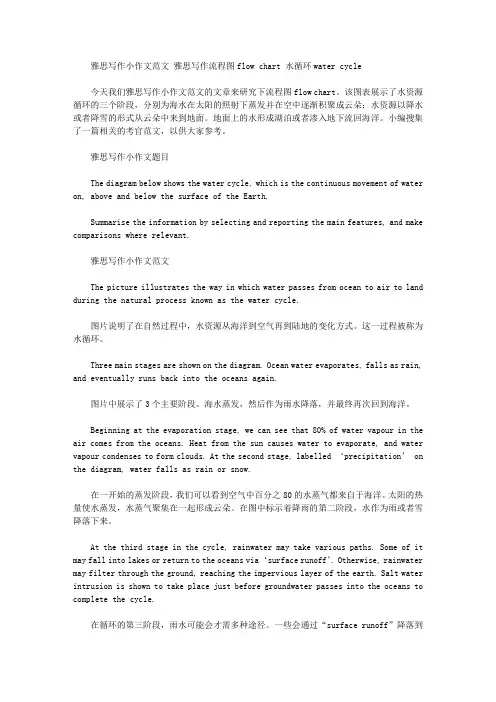
雅思写作小作文范文雅思写作流程图flow chart 水循环water cycle今天我们雅思写作小作文范文的文章来研究下流程图flow chart。
该图表展示了水资源循环的三个阶段,分别为海水在太阳的照射下蒸发并在空中逐渐积聚成云朵;水资源以降水或者降雪的形式从云朵中来到地面。
地面上的水形成湖泊或者渗入地下流回海洋。
小编搜集了一篇相关的考官范文,以供大家参考。
雅思写作小作文题目The diagram below shows the water cycle, which is the continuous movement of water on, above and below the surface of the Earth.Summarise the information by selecting and reporting the main features, and make comparisons where relevant.雅思写作小作文范文The picture illustrates the way in which water passes from ocean to air to land during the natural process known as the water cycle.图片说明了在自然过程中,水资源从海洋到空气再到陆地的变化方式。
这一过程被称为水循环。
Three main stages are shown on the diagram. Ocean water evaporates, falls as rain, and eventually runs back into the oceans again.图片中展示了3个主要阶段。
海水蒸发,然后作为雨水降落,并最终再次回到海洋。
Beginning at the evaporation stage, we can see that 80% of water vapour in the air comes from the oceans. Heat from the sun causes water to evaporate, and water vapour condenses to form clouds. At the second stage, labelled ‘precipitation’ on the diagram, water falls as rain or snow.在一开始的蒸发阶段,我们可以看到空气中百分之80的水蒸气都来自于海洋。
《蚕丝制作》Sample:As is displayed in the first diagram, the life cycle of the silkworm can be categorized into 4 main stages. First, the life of the silkworm starts from eggs propagated by the moth, and it takes 10 days for each egg to become a silkworm larva that feeds on mulberry leaves. Silkworm larva continues to grow in 4 to 6 weeks, then wrapping itself with silk thread to construct a cocoon in the next 3 to 8 weeks. A moth can be produced from the cocoon in 16 days. The life cycle begins again from then on.Overall, the two diagrams reveal the stage of producing cocoons in the life cycle of the silkworm can be used to make silk cloth through 5 simple stepsCambridge IELTS 6 Version:The first diagram shows that there are four main stages in the life of the silk worm.First of all, eggs are produced by the moth and it takes ten days for each egg to become a silkworm larva that feeds on mulberry leaves. This stage lasts for up to six weeks until the larva produces a cocoon of silk thread around itself. After a period of about three weeks, the adult moths eventually emerge from these cocoons and the life cycle begins again. The cocoons are the raw material used for the production of silk cloth. Once selected, they are boiled in water and the threads can be separated in the unwinding stage. Each thread is between 300 and 900 metres long, which means they can be twisted together, dyed and then used to produce cloth in the weaving stage.Overall, the diagrams show that the cocoon stage of the silkworm can be used to produce silk cloth through a very simple process.《玻璃的再生》范文:As is displayed in the flow chart, the recycling process of glass is really a complex one.The overall process can be categorized into 3 stages. First, glass products in various forms are gathered in the Collection point, so that they are easily transported by special trucks or vans to the Cleaning plant, where they get sterilization by high-pressured water. There are three differentchannels in the Recycling plant, namely Brown, Green and Clear, which represent the colors of glass. After recycled in the furnace , glass products are melted into recycled liquid glass. Mixed with new liquid glass, the compound is finally moulded into solid glass, which, afterwards, will be sent to various customer supermarkets for selling. Thus, the glass will go to the customers for different purposes.Through a brief introduction of the circle of glass recycling, we come to realize that recycling plays a vital role in environmental protection and ecological preservation.water filter:The digram illustrates the complete process of water filtering . As can be seen from the flow chart, the gathering procedure of water purifying is similar to the water evaporation.The first step is to prepare a large container with several green plans and a small bottle on the middle of the bottom. Then, a piece of plastic sheet on the plane of the mouth of the bigger container. In order to prevent the plastic film from moving, four stones are placed on each edges respectively.After the preparation, the device can produce the clean water. Thanks to the sunlight shining, the vapor from the green plants rises up to the atmosphere and alters to liquid that accumulates on the lowest point of the plastic coating when it meets the cool air. Subsequently, the pure water drops into the bottom container directly, the pure water collection is accomplished via the principle of evaporation of green plants.《户外取水》范文:The chart describes how water is obtained outdoors.According to the figure, the first step of obtaining water outdoors is to find a hole with green plants on its bottom. Next, remove the green plants in the middle and put a container there. Then, cover the hole with a plastic sheet and place two stones on both ends of it to secure its position. A third stone is laid on the middle of the plastic sheet so that the middle part is also the lowest part.When the sun shines on the green plants in the hole, water evaporates from these plants. The vapor rises up and then cools down to form water drops on the plastic sheet. When there is more and more water, it flows along the sheet to accumulate on the lowest part. Finally, water falls down into the container directly under the middle stone.Thus, water is collected successfully through evaporation from green plants.《房屋不同季节的构造》范文:As is displayed in the flow chart, the principles of insulation in cool and warm climate respectively differ to a large extent.As to the situation of cool climate, we adopt the high-angled roof in order to be nearly parallel with the direction of the sun so that the direct exposition to the heat of sun is lessened as much as we can. By this, the temperature of the material won’t fluctuate within a large range. Meanwhile, thermal building material could enhance the heat storage insulation, preventing outflow, thus reduction of heat.Adversely, in warm climate, reflective building material is indispensable with overhands for shade. The direction of the roof is almost vertical to the direction of the sun to lead to external insulation reflection. By this, ventilation would result in the removal of heat storage rather thanreduction.Through the different working principles of ventilation, we are fascinated by the masterpieces of modern science and technology.《超市建造地点选择》范文:As is unfolded in the map, Place M and N have their unique pros and cons as to the place for building the supermarket.First of all, Place N is located in the urban area of the G town, which may have more population and business. This advantage is incomparable with Place M. What’s more, Main road runs across the center area with convenience in traffic and logistics for the market afterwards. However, the place is equally far away from the neighborhood and the suburb area and cannot attract the residents in the outskirts.As a double-edged sword, Place M is more specifically customer-oriented. In spite of its comparably remote location with Place N, it would attract more customers in the outskirts, for they are reluctant to make a long trip for shopping. On the other hand, the train line nearby will also bring convenience in traffic to the urban -dwellers. Situated to the north-west of Place N, Place M is near the A and B Town with total population of 23 million, far outnumbering the overall population of D and E town, with 12 million.What’s worthy of being mentioned is that fierce competition in Place N and probable monopoly in Place M should also be taken into account when building the supermarket.《化肥的制作》范文:As is shown in the flow chart, the process of recycling organic waste to produce compost is really a complex one.The whole process can be categorized into five stages . First of all, prepare a plastic container which has four holes for ventilating the air. There is a rule when putting waste into the container, food at the bottom within 15 centimeters high, grass at the middle and newspaper at the top within 15 centimeters high altogether, in order to make a optimum (appropriate) environment for different bacteria细菌reproducing. In the following stage, we can witness nitrogen氮and water being put into the container. What's worth mentioning is that water is only added in a hot weather. Next, heat the waste and let the bacteria reproduce fastly, with which the organic waste can be decomposed and became garden fertiliser after 6 months. Subsequently, we can carry the compost out and move it to the garden, thus a new recycling can begin.In conclusion, using this way to turn the organic waste into garden fertiliser 化肥is environmentally friendly. By enlarging the number orvolume of the container, we can dispose more waste at the same time.。
《蚕丝制作》Sample:As is displayed in the first diagram, the life cycle of the silkworm can be categorized into 4 main stages. First, the life of the silkworm starts from eggs propagated by the moth, and it takes 10 days for each egg to become a silkworm larva that feeds on mulberry leaves. Silkworm larva continues to grow in 4 to 6 weeks, then wrapping itself with silk thread to construct a cocoon in the next 3 to 8 weeks. A moth can be produced from the cocoon in 16 days. The life cycle begins again from then on.Focusing on the second diagram, it illustrates the 5 main steps of the procedure of producing silk cloth. Well generated cocoons will be selected firstly. Before the silk thread can be unwound, cocoons have to be boiled in hot water. One cocoon can produce approximately 300 to 900 metres of silk thread. The unwound thread will be dyed afterwards to be weaved into silk cloth.Overall, the two diagrams reveal the stage of producing cocoons in the life cycle of the silkworm can be used to make silk cloth through 5 simple stepsCambridge IELTS 6 Version:The first diagram shows that there are four main stages in the life of the silk worm.First of all, eggs are produced by the moth and it takes ten days for each egg to become a silkworm larva that feeds on mulberry leaves. This stage lasts for up to six weeks until the larva produces a cocoon of silk thread around itself. After a period of about three weeks, the adult moths eventually emerge from these cocoons and the life cycle begins again. The cocoons are the raw material used for the production of silk cloth. Once selected, they are boiled in water and the threads can be separated in the unwinding stage. Each thread is between 300 and 900 metres long, which means they can be twisted together, dyed and then used to produce cloth in the weaving stage.Overall, the diagrams show that the cocoon stage of the silkworm can be used to produce silk cloth through a very simple process.《玻璃的再生》范文:As is displayed in the flow chart, the recycling process of glass is really a complex one.The overall process can be categorized into 3 stages. First, glass products in various forms are gathered in the Collection point, so that they are easily transported by special trucks or vans to the Cleaning plant, where they get sterilization by high-pressured water. There are three different channels in the Recycling plant, namely Brown, Green and Clear, which represent the colors of glass. After recycled in the furnace , glass products are melted into recycled liquid glass. Mixed with new liquid glass, the compound is finally moulded into solid glass, which, afterwards, will be sent to various customer supermarkets for selling. Thus, the glass will go to the customers for different purposes.Through a brief introduction of the circle of glass recycling, we come to realize that recycling plays a vital role in environmental protection and ecological preservation.water filter:The digram illustrates the complete process of water filtering . As can be seen from the flow chart, the gathering procedure of water purifying is similar to the water evaporation.The first step is to prepare a large container with several green plans and a small bottle on the middle of the bottom. Then, a piece of plastic sheet on the plane of the mouth of the bigger container. In order to prevent the plastic film from moving, four stones are placed on each edges respectively.After the preparation, the device can produce the clean water. Thanks to the sunlight shining, the vapor from the green plants rises up to the atmosphere and alters to liquid that accumulates on the lowest point of theplastic coating when it meets the cool air. Subsequently, the pure waterdrops into the bottom container directly, the pure water collection is accomplished via the principle of evaporation of green plants.《户外取水》范文:The chart describes how water is obtained outdoors.According to the figure, the first step of obtaining water outdoors is to find a hole with green plants on its bottom. Next, remove the green plants in the middle and put a container there. Then, cover the hole with a plastic sheet and place two stones on both ends of it to secure its position. A third stone is laid on the middle of the plastic sheet so that the middle part is also the lowest part.When the sun shines on the green plants in the hole, water evaporates from these plants. The vapor rises up and then cools down to form water drops on the plastic sheet. When there is more and more water, it flows along the sheet to accumulate on the lowest part. Finally, water falls down into the container directly under the middle stone.Thus, water is collected successfully through evaporation from green plants.《房屋不同季节的构造》范文:As is displayed in the flow chart, the principles of insulation in cool and warm climate respectively differ to a large extent.As to the situation of cool climate, we adopt the high-angled roof in order to be nearly parallel with the direction of the sun so that the direct exposition to the heat of sun is lessened as much as we can. By this, the temperature of the material won’t fluctuate within a large range. Meanwhile, thermal building material could enhance the heat storage insulation, preventing outflow, thus reduction of heat.Adversely, in warm climate, reflective building material is indispensable with overhands for shade. The direction of the roof is almost vertical to the direction of the sun to lead to external insulation reflection. By this, ventilation would result in the removal of heat storage rather than reduction.Through the different working principles of ventilation, we are fascinated by the masterpieces of modern science and technology.《超市建造地点选择》范文:As is unfolded in the map, Place M and N have their unique pros and cons as to the place for building the supermarket.First of all, Place N is located in the urban area of the G town, which may have more population and business. This advantage is incomparable with Plac e M. What’s more, Main road runs across the center area with convenience in traffic and logistics for the market afterwards. However, the place is equally far away from the neighborhood and the suburb area and cannot attract the residents in the outskirts.As a double-edged sword, Place M is more specifically customer-oriented. In spite of its comparably remote location with Place N, it would attract more customers in the outskirts, for they are reluctant to make a long trip for shopping. On the other hand, the train line nearby will also bring convenience in traffic to the urban -dwellers. Situated to the north-west of Place N, Place M is near the A and B Town with total population of 23 million, far outnumbering the overall population of D and E town, with 12 million.What’s worthy of being mentioned is that fierce competition in Place N and probable monopoly in Place M should also be taken into account when building the supermarket.《化肥的制作》范文:As is shown in the flow chart, the process of recycling organic waste to produce compost is really a complex one.The whole process can be categorized into five stages . First of all, prepare a plastic container which has four holes for ventilating the air. There is a rule when putting waste into the container, food at the bottom within 15 centimeters high, grass at the middle and newspaper at the top within 15 centimeters high altogether, in order to make a optimum (appropriate) environment for different bacteria细菌reproducing. In the following stage, we can witness nitrogen氮and water being put into the container. What's worth mentioning is that water is only added in a hot weather. Next, heat the waste and let the bacteria reproduce fastly, with which the organic waste can be decomposed and became garden fertiliser after 6 months. Subsequently, we can carry the compost out and move it to the garden, thus a new recycling can begin.In conclusion, using this way to turn the organic waste into garden fertiliser 化肥is environmentally friendly. By enlarging the number or volume of the container, we can dispose more waste at the same time.。
雅思写作小作文范文雅思写作流程图flow chart 洪水与堤防今天我们雅思写作小作文范文的相关文章来研究下流程图。
流程图是雅思写作考试中比较少考到的一种题型。
有些老师甚至会在课堂上直接略过它。
但近年来,这种非主流题型的出现频率明显上升,因此大家还是要好好准备一下,最起码知道基本的答题套路才行。
小编搜集了一篇考官范文,以供大家参考。
雅思写作小作文题目The diagrams below show how houses can be protected in areas which are prone to flooding.Summarise the information by selecting and reporting the main features, and make comparisons where relevant.雅思写作小作文范文The diagrams compare two different methods of defense for homes which are at risk of being flooded.这张图表比较了两种保护方案。
他们可以用于保护面临洪水威胁的房子。
The key difference between the diagrams is that they show flood protection with and without a stopbank. In either case, the at-risk home is raised on stilts above ground level.图表中的关键差别在于在洪水防治的过程中有没有防水堤。
在两种情况下,处于风险之中的房子都由柱子支撑着脱离了地面。
The first diagram shows how a stopbank acts as a flood barrier to stop river water from flooding homes. The stopbank is a small mound of land next to the river that is higher than the 100-year flood level and prevents the river from bursting its banks. Nearby houses can be built on stilts to prevent flooding from rainwater, and a floodgate beneath the stopbank can be opened to allow this ‘ponding’ to drain off into the river.第一张图表展示了防水堤如何作为阻挡洪水的障碍防止水流淹没房子。
流程图(flowchart)又名:过程流程图(process flowchart),服务流程图(process flow diagram)方法演变:概略流程图,自上而下流程图,细节流程图,流程展开图,多层次流程图➢概述流程图是按顺序分别描述过程的各个阶段的图表。
它可以按顺序展示操作,进入或流出系统的材料或服务,需要作的决定以及所涉及的人,每步所需的时间,以及过程措施。
描述的过程可以是任何事情:管理或服务过程、制造过程、质量改进计划过程。
该工具作为七种质量控制工具中的一种,有广泛的用途。
➢适用场合·对已完成的过程形成更好的理解;·研究改进过程时;·和别人交流过程实施时;·与同一个项目的相关人员进行更好的交流;·对过程进行记录时;·计划项目时。
➢实施步骤所需材料:卡片或商务贴、一大张挂纸或新闻用纸、记号笔。
1确定要画的过程。
将它写在一张大卡片或商务贴上,并放在顶部。
讨论决定过程涉及的范围:过程从哪里或何时开始?在哪里或何时结束?讨论决定图中包含的细节程度。
2用头脑风暴法找出过程中发生的所有步骤。
在每张卡片上写下一个。
虽然按顺序能够帮助我们想起所有的步骤,但此时顺序并不重要。
3按合理的顺序排列步骤。
4当图中包含了所有的步骤并且所有人都对此流程图达成一致意见时,在各个步骤间用箭头表示过程的流向。
与过程中涉及的其他人一起检查流程图(包括工人、主管、供应商、顾客),以确保无误。
下面是几种流程图的演变。
由于仍有一些其他种类流程图可以用于不同的情况,所有它们被单独列出。
参阅“箭头图”、“流程展开图”、“自上而下流程图”以及“工作流程图”。
➢注意事项·不要担心画流程图的方法不对。
正确的方法就是能帮助组员了解过程的方法。
·在流程图主要包括参与过程的所有关键人物。
这包括那些在过程中起到作用的人:供应商、顾客和主管。
可以通过事前采访他们,和/或在间歇时给他们看正在绘制中的流程图,并获得反馈信息。
Flow chart = process diagram一、流程图的特点1. 描绘某一事物的发展或运作过程2. 遵循某种顺序3. 图中会标出原材料的名称和步骤的细节4. 一般会出现一些专业生词5. 流程最终要达成某种目的或结果二、流程图的写作步骤1. 读题目,确定描述什么?目的或结果?2. 找信息,定步骤所有的信息点,包括图中所有有文字的地方,或所有表示动作或变化的图示(所有的时间、大小、距离等数字信息)1.定框架,写文章第一段:介绍流程图是做什么的。
第二段:详细介绍原料与准备、每一步的变化、过程及结果。
第三段:简单总结2.读文章,做检查单词拼写、语法、替换重复的词汇等。
三.流程图常用的表达1. The flow chart illustrates the recycling process of _____.2. The process of ____ involves the following steps.3. The whole procedure of ___ can be categorised into ____ stages.4. The row materials for ____ include ___, ___ and ____.5. The first step is to ______.6. ____ with ____ is prepared to _____.7. ____ is used as ____ of ____.8. _____ is mixed with ____ to produce _____.9. _____ can change into ____, when ____.10. The process of ____ is really a simple(complicated) process.The pictures below show the recycling process of wasted glass bottles.As is displayed in the flow chart, the recycling process of glass is really a complex one.The overall process can be categorised=classified=divided into three stages.First, glass products in various forms are gathered=assembled in the Collection point, so that they are easily transported by special trucks or vans to the Cleaning plant, where they get sterilisation byhigh-pressured water. There are three different channels in the Recycling plant, namely Brown, Green and Clear, which represent the colors of glass. After recycled in the furnace, glass products are melted=forged into recycled liquid glass. Mixed with new liquid glass, the compound is finally moulded into solid glass, which, afterwards, will be sent to various customer supermarkets for selling. Thus, the glass will go to the customers for different purposes.Through a brief introduction of the circle of glass recycling, we come to realize that recycling plays a vital role inenvironmental protection and ecological preservation.The diagram below describes how to recycle organic waste to produce compost(fertilizer).1. The flow chart illustrates the recycling process of organic waste toproduce fertilizer.As is clearly shown in the picture, the first step is to find a plastic container of two cubic metres and stab several holes on its body so that air could fill in. Secondly, a 15cm thick layer of food is placed at the bottom of the container and grass is put just above the layer for the same height with some news paper covered on the very top. After that, some nitrogen and water are added into the container, and the water should only be hot. Finally, the container is sealed up and the external heat would help the formation of the compost. After six months, when the fertilizer is ready, all we have to do is to pour it into garden soil to nourish plants and flowers.Generally speaking, making garden fertilizer in this way is easy to operate but it costs much time.2. The flow chart shows the whole process of producing fertilizer by recycling organic waste.Firstly, a two cubic metres plastic container is prepared, with some air holes on its body. Secondly, some organic waste is put into the plastic container. The organic waste includes news paper, grass and food. The right order of adding them is putting food in the bottom 15cm of the container and grass in the middle 15cm upon food. News paper is on the very top. Then nitrogen and water are added into the container. What should be noticed isthat water can only be hot water. The next step is to seal up and heat the container. After six months, compost is produced. So we can use them to fertilize the garden.As can be seen from the picture, it is usually simple to change organic waste into fertilizer used to water flowers and trees in the garden.3. The information provided in the diagram is about how to use organic waste to produce compost in the following several simple stages.The first stage is to prepare a plastic container, two cubic metres in volume, with some ventilation holes on the side.Then organic waste such as leaves, pieces of paper and residues can be placed into the container so that three layers (each 15 cm) can be formed in the bottom---news paper, grass and food respectively from up to down. The next important step is to add nitrogen into it and then pour hot water only in to mix together. What is remembered to do next is that the container needs to be sealed and heated. As a result, the vapor can be emitted through the holes located on its body. After that it takes roughly six months to convert into composts and then they are ready for fertilizing plants and flowers in the garden.。